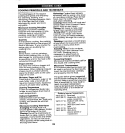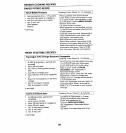
COOKING GUIDE
COOKING PRINCIPLES AND TECHNIQUES
The advantages of microwave Reheating: Cooked food reheats
cooking are speed and efficiency, extremely well by using a low level
For warming, heating, and of microwave energy. Place denser
defrosting, nothing compares. Here foods near the outer edge of the
are a few tips that will make dish when reheating.
microwaving easier and more Covering: Most foods will cook and
enjoyable, reheat better when covered. Pierce
plastic wrap to vent steam.
Microwave Cooking Principles Stirring: Stir foods to help cook/
Because microwave cooking
reheat more quickly and evenly.
requires only one-quarter to one- Turning Over: To promote even
third the time of conventional
cooking, cooking principles cooking, turn larger solid items
become even more important, such as roasts or baked potatoes
over halfway through the cooking
Quantity time.
In microwave cooking, the cooking Shielding: Use small, smooth strips
time is dependent on the amount of of aluminum foil to prevent corners
food in the oven. If you double the and thin or bony areas from
recipe, plan on doubling the overcooking.
cooking time. Standing TTrne: Foods continue
Density cooking even after removal from
Dense foods, such as potatoes, the oven. Standing time is
need more cooking time, as they necessary to allow foods to
take longer for microwave energy complete cooking/defrosting.
to penetrate and for the heat robe Converting Recipes
conducted through them. Microwave recipes will likely call for
Shape and Size less liquid and cooking time.
Cut food into uniform shapes and Microwave Thermometers
sizes for even cooking in the A microwave-safethermometercan
microwave. When cooking irrecJular be used to achieve the best results,
shapes (such as chicken pieces-), Insert the thermometer carefully
place the thicker parts to the outer and properly into the food.
edge of the dish.
Moisture, Sugar and Fat The guide belowgives suggested
Food high in moisture, sugar or fat thermometer readings for meat and
cook faster. Add a minimum of poultry. Keep in mind that standing
liquid to moisten foods. Excessive time is essential for most food to
amounts of water slow cooking, reach its proper temperature.
Internal temperatures should be
measured after 5-10 minutes of
Starting Temperature
Frozen or refrigerated foods take standing time.
longer to microwave than food at
room temperature. Guide to Internal Temperatures
Delicate Ingredients 145°F(63°C). Rare beef
Delicate foods such as eggs, 150°F (66°C). Vegetables, hotdrinks,
cheese, mayonnaise, etc., cook very soups, casseroles
quickly, and should be watched 160°F (71°C). Medium beef, lamb,
carefully, veal, pork
170°F (77°C). Well-done beef, lamb,
Microwave Cooking Techniques
Arranging:Arrange food in a pork
circular pattern, with denser, thicker 170°F (77°C). Whole fish
185°F (85°C). Well-done,
items at the edge of the dish.
Piercing: Pierce the membrane of poultry pieces or
roasted bird
foods such as eggs, oysters, snails,
sausages, livers, clams and whole
vegetables, so they do not burst.
Pierce pouches when using cook-in-
the-bag food items.
23


















